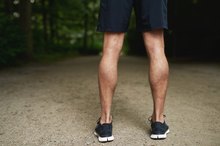Lifting Weights & Tendonitis
Although you should expect some soreness when lifting weights, the line between soreness and pain can get blurry. Whether you have lifted weights for a few years or a few months, chances are you might have the experienced chronic pain or inflammation in your joints called tendonitis 2. The good news is that tendonitis can be prevented and treated to a full recovery, but if left untended, can stop you from lifting weights and exercising altogether.
If you are experiencing serious medical symptoms, seek emergency treatment immediately.
Definition
The tendons in your body connect muscle and bone. According to the bodybuilding website Muscle & Strength, constant repetitive motion that pulls on the tendons tightens them and makes them susceptible to microscopic tearing 3. When the tendon has microtears, inflammation occurs, which results in tendonitis.
Causes
Iliopsoas Tendon Pain When Walking
Learn More
Along with acute injury, tendonitis is caused by repetitive stresses that eventually wear down the joints over time. Performing monotonous workouts with little variation and lifting heavier weights cause tendonitis because this tension strains the tendons. For example, a weightlifter who continually works his chest by doing heavy bench presses can develop tendonitis in his shoulders and elbows. Weightlifters are not the only athletes who can develop tendonitis. Tennis players and swimmers develop their own forms — tennis elbow and swimmer's shoulder, respectively.
- Along with acute injury, tendonitis is caused by repetitive stresses that eventually wear down the joints over time.
- Performing monotonous workouts with little variation and lifting heavier weights cause tendonitis because this tension strains the tendons.
Types of Tendonitis
The severity of tendonitis is measured by four grades with Grade 1 the least painful and Grade 4 the most painful.
Mild pain around the affected tendon after exercise is typical of Grade 1 tendonitis, the Running Planet website reports. This is the stage where treatment will prevent further damage.
Grade 2 tendonitis is where the line blurs between pain and soreness: A weightlifter will feel pain around the tendon at the beginning of an activity; the pain subsides during exercise but comes back after exercising. The pain is not severe and it is easy to exercise through it.
Grade 3 tendonitis features noticeable swelling all over the affected tendon, which becomes painful throughout and after physical activity. Your range of motion also becomes restricted.
A weightlifter suffering from Grade 4 tendonitis will experience moderate to severe pain during everyday activities, making exercise impossible. By this point, professional treatment is suggested.
- The severity of tendonitis is measured by four grades with Grade 1 the least painful and Grade 4 the most painful.
- Grade 3 tendonitis features noticeable swelling all over the affected tendon, which becomes painful throughout and after physical activity.
Treatment
How Does a Supraspinatus Tendon Heal Itself?
Learn More
Tendonitis can be completely cured if acknowledged and treated immediately during the Grade 1 stage. To best treat tendonitis, stop the activity that causes pain and use rest, ice and anti-inflammatory agents to reduce swelling and relieve pain. Severe tendonitis can rupture the tendon, which requires surgical repair. If the tendonitis reaches Grades 3 or 4, consult your doctor.
- Tendonitis can be completely cured if acknowledged and treated immediately during the Grade 1 stage.
Prevention
The best way to prevent tendonitis is properly warming up your muscles before working out and stretching them afterward.
For warm-ups, perform dynamic stretching that mimics the exercises you will later perform. For example, for the lower body, do lunges, butt kicks and body-weight squats to loosen your hamstrings and hip flexors. For the upper body, pushups and Cuban presses with light weights will help loosen the rotator cuffs. After working out, perform the classic "grab and hold" stretches.
Wearing protective belts and straps for the wrists, ankles and knees will also stabilize your joints when lifting extremely heavy weight.
Poor lifting technique can contribute to tendonitis, so if you are unsure of your technique, consult a certified personal trainer or a strength-and-conditioning specialist to develop the proper form for weight training 3.
- The best way to prevent tendonitis is properly warming up your muscles before working out and stretching them afterward.
- For warm-ups, perform dynamic stretching that mimics the exercises you will later perform.
Related Articles
References
- Home Therapy: Advanced Treatment for Tendonitis
- NetDoctor: I have tendonitis
- Muscle & Strength: Tendonitis Fact Sheet
- Cleveland Clinic. Tendinitis. Updated February 23, 2015.
- Lopez RG, Jung HG. Achilles tendinosis: treatment options. Clin Orthop Surg. 2015;7(1):1–7. doi:10.4055/cios.2015.7.1.1
- Ling SK, Lui TH. Posterior tibial tendon dysfunction: an overview. Open Orthop J. 2017;11:714–723. doi:10.2174/1874325001711010714
- Schwartz A, Watson JN, Hutchinson MR. Patellar tendinopathy. Sports Health. 2015;7(5):415–420. doi:10.1177/1941738114568775
- Chianca V, Albano D, Messina C, et al. Rotator cuff calcific tendinopathy: from diagnosis to treatment. Acta Biomed. 2018;89(1-S):186–196. doi:10.23750/abm.v89i1-S.7022
- Vaquero-Picado A, Barco R, Antuña SA. Lateral epicondylitis of the elbow. EFORT Open Rev. 2017;1(11):391–397. doi:10.1302/2058-5241.1.000049
- Skinner TM. Intersection Syndrome: The subtle squeak of an overused wrist. J Am Board Fam Med. 2017;30(4):547-551. doi:10.3122/jabfm.2017.04.170053
Writer Bio
Specializing in health and fitness writing, Lance Fuller is currently interning for the National Education Association in Washington, D.C. Fuller was the first student to write about health and fitness for "The Independent Florida Alligator," America's largest student-run college newspaper. Fuller holds a Bachelor of Science in journalism, focusing on health and fitness writing, from the University of Florida.









